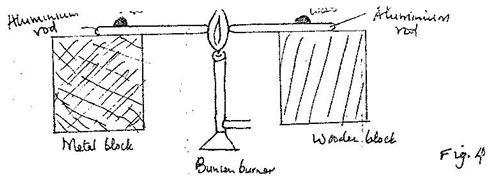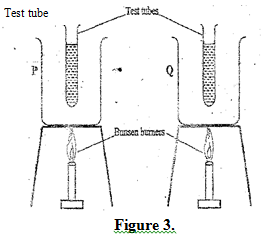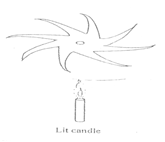|
1. 1995 Q10 P1
In the set up shown in figure 3, water near the top of the boiling tube boils while at the bottom it remains cold. In the set up shown in figure 3, water near the top of the boiling tube boils while at the bottom it remains cold. Give a reason for the observation (1mark)
2. 1996 Q7 P1
Give a reason why heat transfer by radiation is faster than heat transfer by conduction (1mark) 3. 1998 Q9 P1 Water of mass 3kg at a temperature of 90oC is allowed to cool for 10 minutes. State two factors other than humidity, that determines the final temperature. 4. 2000 Q8 P1 A wooden bench and a metal bench are both left in the sun for along time. Explain why the metal bench feels hotter to touch. 5. 2000 Q22 P1 Two identical blocks of copper are taken from the same furnace. One block is dropped into a well - lagged calorimeter containing 200g of methylated spirit. Both water and spirit were initially at the same temperature. After being given time to stabilize the temperature, it was found that more spirit than water had evaporated. State two factors that could have caused this difference. 6. 2001 Q19 P1 Fig 12 shows two identical containers A and B into which a copper rod is fitted. The containers are well lagged.
The liquids in the containers were initially at the same temperature if the heat is a applied continuously at the position shown, state with reason for the container through which the loss of heat is likely to be higher.
7. 2002 Q7 P1 An electric heater is placed at equal distances from two similar metal cans A and B filled with water at room temperature. The outer surface of can is shiny while that of can B is dull black. State with reasons which can will be at a higher temperature after the heater is switched on for some time. 8. 2003 Q7 P1 When a Bunsen burner is lit below wire gauze, it is noted that the flame initially burns below the gauze as shown in Figure 5 (i).After sometime, the flame burns below as well as above the gauze as shown in Figure 5(ii).
Explain this observation
9. 2004 Q7 P1 Two identical aluminium rods as shown in figure 4. One rests on metal block the other on the wooden Block. The protruding ends are heated on a Bunsen burners shown. State with reason on which bar the wax is likely to melt.
10. 2005 Q5 P1
In a vacuum flask the walls enclosing the vacuum are silvered on the inside. State the reason for this. (1marks) 11. 2007 Q6 P1 Figure 4 show two identical balloons A and B. The balloons were filled with equal amounts of the same type of gas. The balloons are suspended at distances X1 and X2 from a metal cube filled with boiling water and placed on an insulating material. Use this information to answer questions 11 and 12. State the mode by which heat travels from the cube to the balloons (1 mark)
12. 2007 Q7 P1
The face of the cube towards A is bright and shiny and the face towards B is dull black. State with reason the adjustments that should be made on the distances X1 and X2 so that the rate of change of temperature in both balloons is the same. (2 marks) 13. 2007 Q14 P1 Figure 8 shows a uniform light bar resting horizontally on corks floating on water in two beakers A and B. Explain why the bar tilts towards side A when equal amount of heat is supplied to each beaker (2 marks)
14. 2008 Q6 P1
Fig. 3 shows a hot water bath with metal rods inserted through one of its sides. Some wax is fixed at the end of each rod. Use this information to answer questions 14 and 15. What property of metals could be tested using this set-up? (1mark)
15. 2008 Q7 P1
Besides the length of the rods that is kept constant, what else should be kept constant when comparing the property for the different metal rods? (1mark) 16. 2009 Q7 P1 Use the following information to answer questions 16 and 17
Two identical empty metal containers P and Q are placed over identical bunsen burners and the burners lit. P is dull black while Q is shiny bright. After each container attains a temperature of 1000C the burners are turned off . Identical test tubes containing water are suspended in each container without touching the sides as shown in the figure 3.
Figure 3. Explain why the container Q may become hot faster than P. (2 marks) 17. 2009 Q8 P1 Explain why the water in test-tube in P becomes hotter faster than in Q. (2 marks) 18. 2010 Q4 P1 A paper windmill in a horizontal axis was placed above a candle as shown in figure 2. When the candle was lit the paper windmill begun to rotate. Explain this observation.
19. 2011 Q5 P1
Figure 4 shows two identical beakers P and Q full of water at 90 degrees centigrade. Two similar cold wet clothes are wrapped, one around the top of P and the other around the bottom of Q. State with a reason, the beaker in which the water cools faster. (2 marks)
20. 2012 Q17a-c P1
(a) Figure 11 shows how an underground room was ventilated. It had two vents, one at A and other at B. A fire was lit at point C.
Explain what happened to the ventilation when the fire was lit. (3 marks)
(b) Explain how a vacuum flask minimizes loss of heat through radiation (1 mark)
(c) In an experiment to investigate the unusual expansion of water, a fixed mass of water at 00C was heated until its temperature reached 200c .On the axis provided, sketch a graph of density against temperature of the water from00C to 200c (2marks)
2 Comments
|
CATEGORIES
Categories
All
Topics
FORM I - PHYSICS SYLLABUSFORM II - PHYSICS SYLLABUSTOPICS
FORM III - PHYSICS SYLLABUSFORM IV - PHYSICS SYLLABUSARCHIVES
RSS FEEDS
AUTHOR
M.A NyamotiMy passion is to see students pass using right methods and locally available resources. My emphasis is STEM courses
|
We Would Love to Have You Visit Soon! |
Hours24 HR Service
|
Telephone0728 450425
|
|
8-4-4 materialsLevels
Subjects
|
cbc materialsE.C.D.E
Lower Primary
Upper Primary
Lower Secondary
Upper Secondary
|
teacher support
Other Blogs
|












 RSS Feed
RSS Feed